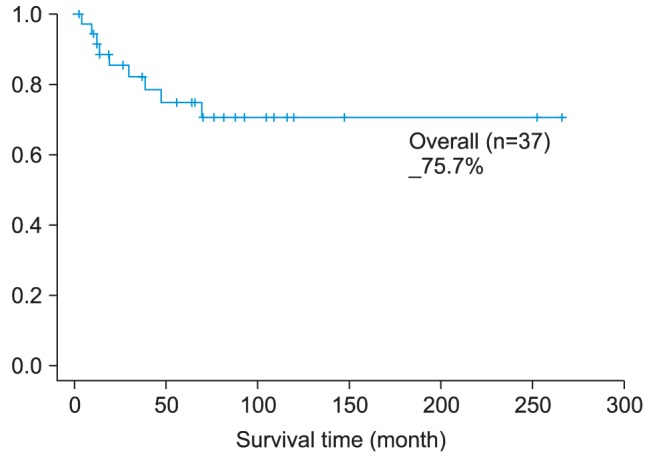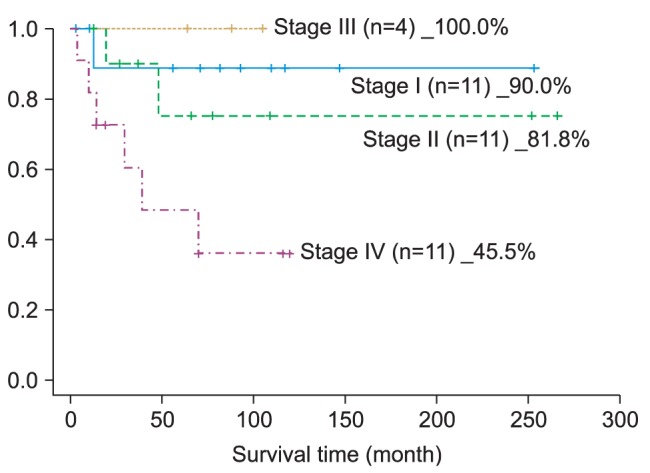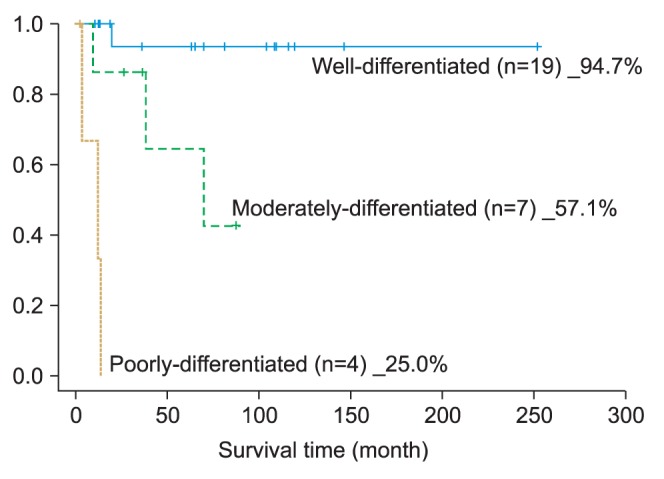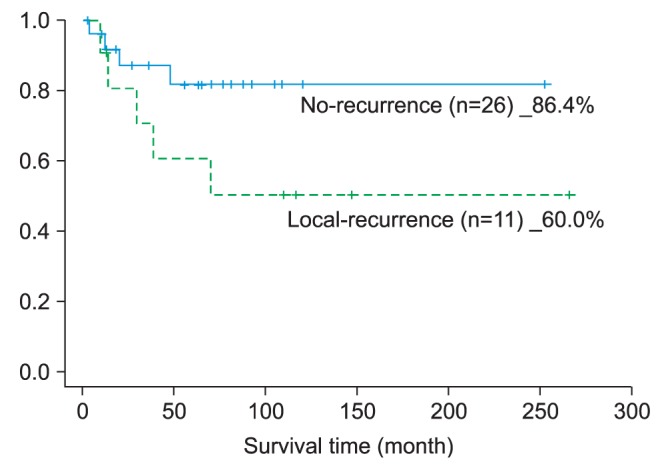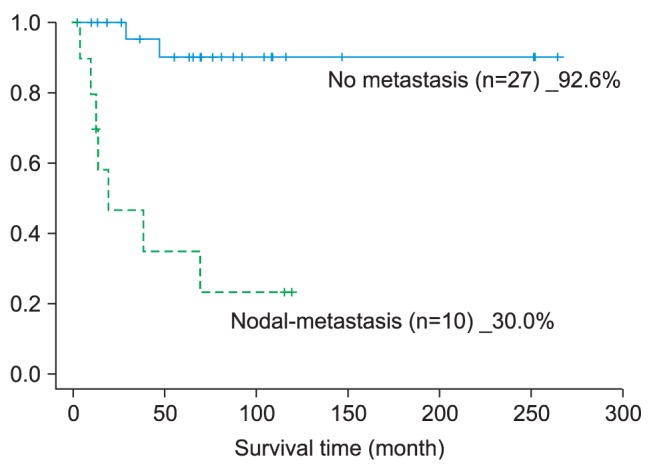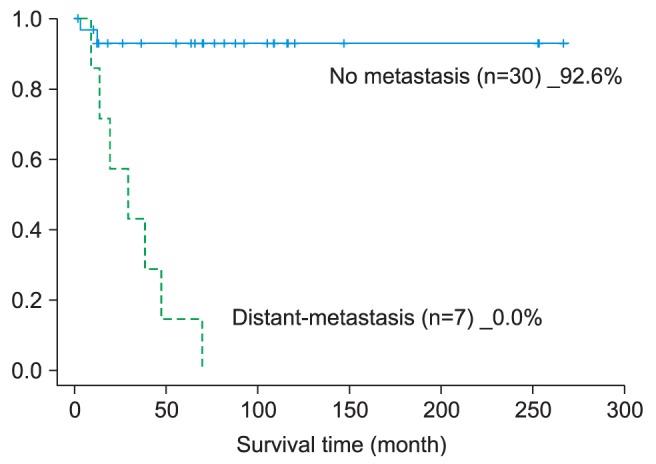J Korean Assoc Oral Maxillofac Surg.
2013 Oct;39(5):207-216.
The impact factors on 5-year survival rate in patients operated with oral cancer
- Affiliations
-
- 1Department of Oral and Maxillofacial Surgery, School of Dentistry, Pusan National University, Yangsan, Korea. kuksjs@pusan.ac.kr
Abstract
OBJECTIVES
The purpose of this study is to analyze clinical impact factors on the survival rate, and to acquire basic clinical data for the diagnosis of oral cancer, for a determination of the treatment plan with long-term survival in oral cancer patients.
MATERIALS AND METHODS
Through a retrospective review of the medical records, the factors for long-term survival rate were analyzed. Thirty-seven patients, among patient database with oral cancer treated in the Department of Oral and Maxillofacial Surgery at Pusan National University Hospital within a period from March 1998 to March 2008, were selected within the study criteria and were followed-up for more than 5 years. The analyzed factors were gender, age, drinking, smoking, primary tumor site, type of cancer, TNM stage, recurrence of affected region, and metastasis of cervical lymph node. The 5-year survival rate on the impact factors was calculated statistically using the Kaplan-Meier method.
RESULTS
By classification of clinical TNM at the 1st visit, there were 11 (29.7%) cases for stage I, 11 (29.7%) cases for stage II, 3 (8.1%) cases for stage III, and 12 (32.5%) cases for stage IV. The 5-year survival rate of total oral cancer patients after the operation were 75.7%, pathological TNM stage related 5-year survival rate were as follows: stage I 90.0%, stage II 81.8%, stage III 100% and stage IV 45.5%; in which the survival rate difference by each stage was significantly observed. The recurrence of cervical lymph node was the significant impact factor for the survival rate, because only 30.0% the survival rate in recurrent cases existed. During the follow-up, there were 15 (40.5%) patients with confirmed recurrence, and the 5-year survival rate of these patients was decreased as 46.7%.
CONCLUSION
The classification of clinical and pathological TNM stage, local recurrence after surgery, and metastasis of cervical lymph node after surgery were analyzed as the 3 most significant factors.
MeSH Terms
Figure
Reference
-
2. Sun JR, Kim SM, Seo MH, Kim MJ, Lee JH, Myoung H. Oral cancer incidence based on annual cancer statistics in Korea. J Korean Assoc Oral Maxillofac Surg. 2012; 38:20–28.
Article3. Woolgar JA, Rogers S, West CR, Errington RD, Brown JS, Vaughan ED. Survival and patterns of recurrence in 200 oral cancer patients treated by radical surgery and neck dissection. Oral Oncol. 1999; 35:257–265. PMID: 10621845.
Article4. Frierson HF Jr, Cooper PH. Prognostic factors in squamous cell carcinoma of the lower lip. Hum Pathol. 1986; 17:346–354. PMID: 3957335.
Article5. Prieto I, Prieto A, Bravo M, Bascones A. Prognostic factors for cancer of the oral cavity. Quintessence Int. 2005; 36:711–717. PMID: 16163874.6. Rodriguez T, Altieri A, Chatenoud L, Gallus S, Bosetti C, Negri E, et al. Risk factors for oral and pharyngeal cancer in young adults. Oral Oncol. 2004; 40:207–213. PMID: 14693246.
Article7. Haigentz M Jr, Hartl DM, Silver CE, Langendijk JA, Strojan P, Paleri V, et al. Distant metastases from head and neck squamous cell carcinoma. Part III. Treatment. Oral Oncol. 2012; 48:787–793. PMID: 22516376.
Article8. Funk GF, Karnell LH, Robinson RA, Zhen WK, Trask DK, Hoffman HT. Presentation, treatment, and outcome of oral cavity cancer: a National Cancer Data Base report. Head Neck. 2002; 24:165–180. PMID: 11891947.
Article9. Kim MY, Kim CS, Lee SH, Kim JW, Jang HJ. A clinicostatistical analysis of oral cancer patients for recent 8 years. J Korean Assoc Oral Maxillofac Surg. 2007; 33:660–668.10. Napier SS, Speight PM. Natural history of potentially malignant oral lesions and conditions: an overview of the literature. J Oral Pathol Med. 2008; 37:1–10. PMID: 18154571.
Article11. Chen JK, Katz RV, Krutchkoff DJ. Intraoral squamous cell carcinoma. Epidemiologic patterns in Connecticut from 1935 to 1985. Cancer. 1990; 66:1288–1296. PMID: 2400977.
Article12. Blot WJ, McLaughlin JK, Winn DM, Austin DF, Greenberg RS, Preston-Martin S, et al. Smoking and drinking in relation to oral and pharyngeal cancer. Cancer Res. 1988; 48:3282–3287. PMID: 3365707.13. Sandoval M, Font R, Mañós M, Dicenta M, Quintana MJ, Bosch FX, et al. The role of vegetable and fruit consumption and other habits on survival following the diagnosis of oral cancer: a prospective study in Spain. Int J Oral Maxillofac Surg. 2009; 38:31–39. PMID: 18951763.
Article14. Kwon HK, Cha IH, Lim SJ, Choi CH, Kim BI. Risk factors for oral cancer; a case-control study. J Korean Assoc Oral Maxillofac Surg. 2002; 28:395–400.15. Krolls SO, Hoffman S. Squamous cell carcinoma of the oral soft tissues: a statistical analysis of 14,253 cases by age, sex, and race of patients. J Am Dent Assoc. 1976; 92:571–574. PMID: 1062459.
Article16. Syrigos KN, Karachalios D, Karapanagiotou EM, Nutting CM, Manolopoulos L, Harrington KJ. Head and neck cancer in the elderly: an overview on the treatment modalities. Cancer Treat Rev. 2009; 35:237–245. PMID: 19100689.
Article17. Shah JP, Patel SG. Head and neck surgery and oncology. 3rd ed. Edinburgh: Mosby;2003.18. Goshen E, Davidson T, Yahalom R, Talmi YP, Zwas ST. PET/CT in the evaluation of patients with squamous cell cancer of the head and neck. Int J Oral Maxillofac Surg. 2006; 35:332–336. PMID: 16280234.
Article19. Nahmias C, Carlson ER, Duncan LD, Blodgett TM, Kennedy J, Long MJ, et al. Positron emission tomography/computerized tomography (PET/CT) scanning for preoperative staging of patients with oral/head and neck cancer. J Oral Maxillofac Surg. 2007; 65:2524–2535. PMID: 18022480.
Article20. Townsend DW, Beyer T, Kinahan PE, Charron M, Dachille M, Meltzer C, et al. Recent studies with a combined PET/CT scanner. Amsterdam, New York: Excerpta Medica Foundation;1999. p. 229–244.21. Ferlito A, Devaney KO, Rinaldo A, Devaney SL, Carbone A. Micrometastases: have they an impact on prognosis? Ann Otol Rhinol Laryngol. 1999; 108:1185–1189. PMID: 10605927.22. Cho JH, Kim CS. Clinical and statistical analysis of the oral cancer patients: a statistical analysis of 256 cases. J Korean Assoc Maxillofac Plast Reconstr Surg. 1998; 20:33–44.23. Lee JW, Kim JW, Kim CS. A clinic-statistical study on cervical lymph node metastasis of oral squamous cell carcinoma. J Korean Assoc Oral Maxillofac Surg. 2008; 34:594–601.24. Oh MS, Kang SH, Kim HJ, Zhenglin Z, Ryu JI, Nam W, et al. Overall five-year survival rate in squamous cell carcinoma of oral cavity. J Korean Assoc Oral Maxillofac Surg. 2009; 35:83–88.25. Koo BS, Lim YC, Lee JS, Choi EC. Management of contralateral N0 neck in oral cavity squamous cell carcinoma. Head Neck. 2006; 28:896–901. PMID: 16721743.
Article26. Zbären P, Nuyens M, Caversaccio M, Stauffer E. Elective neck dissection for carcinomas of the oral cavity: occult metastases, neck recurrences, and adjuvant treatment of pathologically positive necks. Am J Surg. 2006; 191:756–760. PMID: 16720144.
Article27. O'Brien CJ, Traynor SJ, McNeil E, McMahon JD, Chaplin JM. The use of clinical criteria alone in the management of the clinically negative neck among patients with squamous cell carcinoma of the oral cavity and oropharynx. Arch Otolaryngol Head Neck Surg. 2000; 126:360–365. PMID: 10722009.28. Keski-Säntti H, Atula T, Törnwall J, Koivunen P, Mäkitie A. Elective neck treatment versus observation in patients with T1/T2 N0 squamous cell carcinoma of oral tongue. Oral Oncol. 2006; 42:96–101. PMID: 16256414.
Article29. Lindberg R. Distribution of cervical lymph node metastases from squamous cell carcinoma of the upper respiratory and digestive tracts. Cancer. 1972; 29:1446–1449. PMID: 5031238.
Article30. Woolgar JA. Histological distribution of cervical lymph node metastases from intraoral/oropharyngeal squamous cell carcinomas. Br J Oral Maxillofac Surg. 1999; 37:175–180. PMID: 10454023.
Article31. Woolgar JA, Scott J. Prediction of cervical lymph node metastasis in squamous cell carcinoma of the tongue/floor of mouth. Head Neck. 1995; 17:463–472. PMID: 8847204.
Article32. National Comprehensive Cancer Network (US). The complete library of NCCN clinical practice guidelines in oncology. Rockledge: National Comprehensive Cancer Network;2013.
- Full Text Links
- Actions
-
Cited
- CITED
-
- Close
- Share
- Similar articles
-
- Retrospective Study On The Influencing Factors Of Survival Rate After Treatments Of Oral Cancer
- Retrospective study on factors affecting the prognosis in oral cancer patients who underwent surgical treatment only
- Clinical Outcome of the Squamous Cell Carcinoma of Tongue: Experience of National Cancer Center
- Changes in the management and survival rates of patients with oral cancer: a 30-year single-institution study
- Breast Cancer: A 50-year Review of 2,677 Cases

